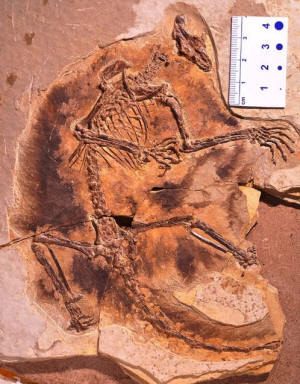|
Scientists on Wednesday announced the discovery of fossils of
two Jurassic Period gliding mammals so well-preserved and
complete that they show the wing-like skin membranes the
creatures employed while gliding effortlessly between trees.
The two species, Maiopatagium furculiferum from Liaoning
Province and Vilevolodon diplomylos unearthed about 40 miles (65
km) away in Hebei Province, come from an extinct early mammalian
side branch.
These two and another apparent glider from about the same time
that was described in 2006 were the vanguard of the mammalian
air force. It was not until more than 100 million years later
that bats, which use powered flight like birds, and more gliding
mammals appeared, following the dinosaurs' demise.
Mammals first appeared roughly 210 million years ago. These
fossils underscore that early mammals were not merely cowering
at the feet of dinosaurs but boasted a range of body plans and
lifestyles. They included beaver-tailed swimmers, tree climbers,
hoppers, burrowers and small carnivores that ate baby dinosaurs.
"Despite living in dinosaur-dominated ecosystems, early mammals
diversified into many ecological niches," said University of
Chicago paleontologist Zhe-Xi Luo, who led the research
published in the journal Nature.
Gliding may have offered Maiopatagium and Vilevolodon advantages
in food-gathering and predator avoidance. They were unrelated to
today's four groups of gliding mammals: flying squirrels in
North America and Asia; Africa's scaly-tailed gliders;
Australia's marsupial sugar gliders; and Southeast Asia's
colugos.
Maiopatagium was about 9 inches (23 cm) long, similar in size to
flying squirrels. Vilevolodon was a bit smaller. Maiopatagium's
teeth resemble those of fruit bats, suggesting it ate soft plant
parts. Vilevolodon's teeth were more like those of squirrels,
good for seed-eating.
Judging from hand and foot bones, the scientists concluded the
two roosted, using all four limbs to hang from trees like modern
colugos, and gripping tree branches with their feet like bats.
"The gliding membranes were attached to the four limbs, likely
at or near the wrists and ankles," University of Chicago
paleontologist David Grossnickle said.
They lived at a time when small feathered dinosaurs like
Anchiornis also were experimenting with flying, on the
evolutionary road leading to birds. They lived alongside
pterosaurs, reptiles that tens of millions of years earlier
became the first flying vertebrates.
(Reporting by Will Dunham; Editing by Sandra Maler)
[© 2017 Thomson Reuters. All rights
reserved.] Copyright 2017 Reuters. All rights reserved. This material may not be published,
broadcast, rewritten or redistributed.

|
|






